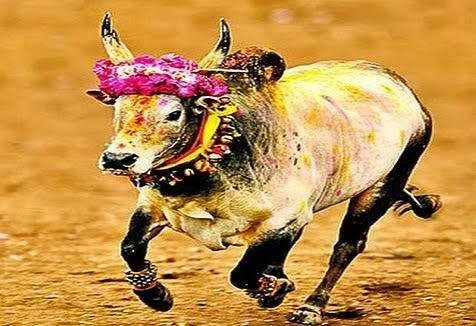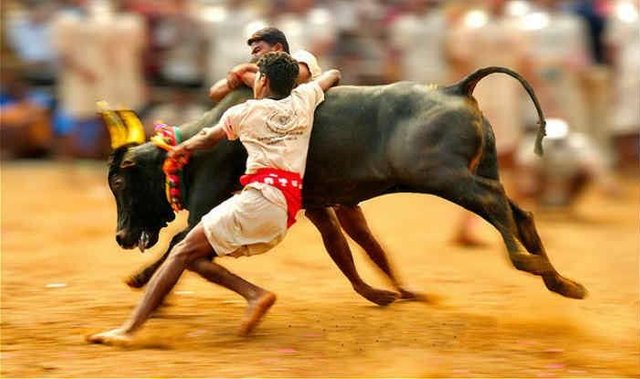Jallikattu and its Unusual facts
 Jallikattu (or sallikkattu), also known as eru thazhuvuthal and manju virattu[2], is a traditional spectacle in which a Bos indicus bull, such as the Pulikulam[3] or Kangayam breeds,[4] is released into a crowd of people, and multiple human participants attempt to grab the large hump on the bull's back with both arms and hang on to it while the bull attempts to escape. Participants hold the hump for as long as possible, attempting to bring the bull to a stop. In some cases, participants must ride long enough to remove flags on the bull's horns.[5][6]
Jallikattu (or sallikkattu), also known as eru thazhuvuthal and manju virattu[2], is a traditional spectacle in which a Bos indicus bull, such as the Pulikulam[3] or Kangayam breeds,[4] is released into a crowd of people, and multiple human participants attempt to grab the large hump on the bull's back with both arms and hang on to it while the bull attempts to escape. Participants hold the hump for as long as possible, attempting to bring the bull to a stop. In some cases, participants must ride long enough to remove flags on the bull's horns.[5][6] 
Vadi manjuviraṭṭu: This is the most common category of Jallikattu. The bull is released from a closed space (vadi vasal) and the contestants attempt to wrap their arms or hands around the hump of the bull and hold on to it to win the award. Only one person is allowed to attempt at a time. This variant is most common in the districts of Madurai, Thanjavur, and Salem.
Vēli viraṭṭu: In this variant the approach is slightly different as the bull is directly released into open ground. The rules are the same as that of vadi majuviraṭṭu. This is a popular variant in the districts of Sivagangai and Madurai. 
Vaṭam manjuviraṭṭu: In this variant, the bull is tied with a 15 m (49 ft) rope (vatam means "rope" in Tamil). There are no other physical restrictions for the bull and hence it can move freely anywhere. The maximum time period given is 30 minutes. A team of seven to nine members can attempt to untie the gift token that is tied on the bull's horn.
Bulls enter the competition area through a gate called the vadi vasal. Typically, participants must only hold onto the bull's hump, and in some variations they are disqualified if they hold onto the bull's neck, horns or tail. There may be several goals to the game depending on region. In some versions, contestants must either hold the bulls hump for 30 seconds or for 15 metres (49 ft).[14] If the contestant is thrown by the bull or falls, they lose. Some variations only allow for one contestant. If two people grab the hump, then neither person wins.[15]
BreedingEdit
Bos indicus bulls are bred specifically by people of the village for the event. Bulls that are able to participate successfully in the Jallikattu event are used as studs for breeding. These bulls also fetch higher prices in the markets.[16]
Animal welfare concerns are related to the handling of the bulls before they are released and also during competitor's attempts to subdue the bull.
Practices before the bull is released include prodding the bull with sharp sticks or scythes, extreme bending of the tail which can fracture the vertebrae, and biting of the bull's tail. There are also reports of the bulls being forced to drink alcohol to disorient them, or chilli peppers being rubbed in their eyes to aggravate the bull.[18]
During attempts to subdue the bull, they are stabbed by various implements such as knives or sticks, punched, jumped on and dragged to the ground. In variants in which the bull is not enclosed, they may run into traffic or other dangerous places, sometimes resulting in broken bones or death.[19][20] Protestors claims that Jallikattu is promoted as bull taming, however, others suggest it exploits the bull's natural nervousness as prey animals by deliberately placing them in a terrifying situation in which they are forced to run away from the competitors which they perceive as predators and the practice effectively involves catching a terrified animal.[21] Along with human injuries and fatalities, bulls themselves sometimes sustain injuries or die, which people may interpret as a bad omen for the village.
An investigation by the Animal Welfare Board of India concluded that "jallikattu is inherently cruel to animals".[22][23]
Animal welfare organisations such as the Federation of Indian Animal Protection Organisations (FIAPO)[24] and PETA India have protested against the practice.[25][26]
Ban, protests and authorizationEdit
See also: 2017 pro-Jallikattu protests
Anti-ban protesters at Marina beach, January 2017.
The Animal Welfare Board of India filed a case in the Supreme Court of India for an outright ban on Jallikattu because of the cruelty to animals and the threat to public safety involved.
On 27 November 2010, the Supreme Court permitted the Government of Tamil Nadu to allow Jallikattu for five months in a year and directed the District Collectors to make sure that the animals that participate in Jallikattu are registered to the Animal Welfare Board and in return the Board would send its representative to monitor the event.[27] The Government of Tamil Nadu ordered that ₹2 lakh (US$3,100) be deposited by the organizers in case of an accident or injury during the event and enacted a rule to allow a team of veterinarians be present at the venue for certifying the bulls for participation in the event and to provide treatment for bulls that get injure